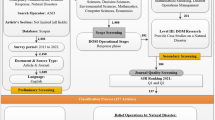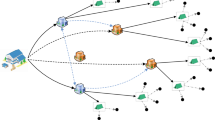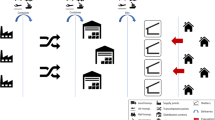Abstract
Organization and efficiency of relief operations are vital following a major disaster, as well as the guarantee that all of the affected population will adequately have their basic needs met. However, in a post-disaster environment, uncertainty often impacts all aspects of the relief efforts. Placement of relief distribution centers, as well as public knowledge of these locations, is crucial to the speed and efficiency of relief efforts. This research develops a formulation to choose a set of distribution centers to open from a list of available facilities and to assign every member of the population to a distribution center. While developing these assignments, the costs to the affected population are considered in the form of travel costs to reach the assigned distribution center. Incorporation of these travel costs, a form of deprivation costs, minimizes the suffering of the population, and inclusion of ideas from fair division minimizes disparities in these costs to provide each member of the affected population with a fair level of service. Further, the inclusion of a term inspired by conditional value-at-risk, or CVaR, into the formulation helps to further minimize potential disparities. Computational results for two datasets will be discussed to show the impact of including deprivation costs in this humanitarian logistics model. Additionally, theoretical results will show that optimal solutions to the formulation are guaranteed to be Pareto efficient.








Similar content being viewed by others
References
Amin, A. (2010). Victims protest unfair distribution of relief goods. Lahore: Daily Times.
Andersson, F., Mausser, H., Rosen, D., & Uryasev, S. (2001). Credit risk optimization with conditional value-at-risk criterion. Mathematical Programming, 89, 273–292.
Artzner, P., Delbaen, F., Eber, J.-M., & Heath, D. (1999). Coherent measures of risk. Mathematical Finance, 9, 203–228.
Atkinson, A. B., & Brandolini, A. (2015). Unveiling the ethics behind inequality measurement: Dalton’s contribution to economics. The Economic Journal, 125, 209–234.
Bao, X., Sahinidis, N. V., & Tawarmalani, M. (2009). Multiterm polyhedral relaxations for nonconvex, quadratically-constrained quadratic programs. Optimization Methods and Software, 24, 485–504.
Bao, X., Sahinidis, N. V., & Tawarmalani, M. (2011). Semidefinite relaxations for quadratically constrained quadratic programs: A review and comparisons. Mathematical Programming, 129, 129–157.
Belotti, P., Miller, A. J., & Namazifar, M. (2010). Valid inequalities and convex hulls for multilinear functions. Electronic Notes in Discrete Mathematics, 36, 805–812.
Brams, S. J. (2008). Mathematics and democracy: Designing better voting and fair-division procedures. Princeton, NJ: Princeton University Press.
Caragiannis, I., Kaklamanis, C., Kanellopoulos, P., & Kyropoulou, M. (2012). The efficiency of fair division. Theory of Computing Systems, 50, 589–610.
Caunhye, A. M., Nie, X., & Pokharel, S. (2012). Optimization models in emergency logistics: A literature review. Socio-Economic Planning Sciences, 46, 4–13.
Craemer, T. (2010). Evaluating racial disparities in Hurricane Katrina relief using direct trailer counts in New Orleans and FEMA records. Public Administration Review, 70, 367–377.
Ergun, Ö., Karakus, G., Keskinocak, P., Swann, J., & Villarreal, M. (2010). Operations research to improve disaster supply chain management. In J. J. Cochran, L. A. Cox, P. Keskinocak, J. P. Kharoufeh, & J. C. Smith (Eds.), Wiley encyclopedia of operations research and management science (pp. 447–462). Hoboken, NJ: Wiley.
Givler, A. E. (2015). A stochastic conditional value-at-risk approach to disaster relief planning, Ph.D. thesis. Troy, NY: Rensselaer Polytechnic Institute.
Gotoh, J., & Uryasev, S. (2016). Two pairs of families of polyhedral norms versus \(\ell _p\)-norms: Proximity and applications in optimization. Mathematical Programming, 156, 391–431.
Himalayan News Service Kathmandu. (2011). Stir against unfair relief distribution. Kathmandu: Himalayan Times.
Holguín-Veras, J., Jaller, M., Wassenhove, L. N. V., Pérez, N., & Wachtendorf, T. (2012). On the unique features of post-disaster humanitarian logistics. Journal of Operations Management, 30, 494–506.
Holguín-Veras, J., Pérez, N., Jaller, M., Wassenhove, L. N. V., & Aros-Vera, M. F. (2013). On the appropriate objective function for post-disaster humanitarian logistics models. Journal of Operations Management, 31, 262–280.
Hurley, J., Buckley, N. J., Cuff, K., Giacomini, M., & Cameron, D. (2011). Judgments regarding the fair division of goods: The impact of verbal versus quantitative descriptions of alternative divisions. Social Choice and Welfare, 37, 341–372.
Jaller, M. (2011). Resource allocation problems during disasters: The cases of points of distribution planning and material convergence handling, Ph.D. thesis. Troy, NY: Rensselaer Polytechnic Institute.
Karsu, Ö., & Morton, A. (2015). Inequity averse optimization in operational research. European Journal of Operational Research, 245, 343–359.
Linderoth, J. T. (2005). A simplicial branch-and-bound algorithm for solving quadratically constrained quadratic programs. Mathematical Programming, 103, 251–282.
Loggins, R. (2015). Improving the resilience of social infrastructure systems to an extreme event, Ph.D thesis. Troy, NY: Rensselaer Polytechnic Institute.
Luss, H. (1999). On equitable resource allocation problems: A lexicographic minimax approach. Operations Research, 47, 361–378.
Mansini, R., Ogryczak, W., & Speranza, M. (2007). Conditional value at risk and related linear programming models for portfolio optimization. Annals of Operations Research, 152, 227–256.
McCormick, G. P. (1976). Computability of global solutions to factorable nonconvex programs: Part I—convex underestimating problems. Mathematical Programming, 10, 147–175.
Mitchell, J. E., Pang, J., & Yu, B. (2014). Convex quadratic relaxations of nonconvex quadratically constrained quadratic programs. Optimization Methods and Software, 29, 120–136.
Noyan, N. (2012). Risk-averse two-stage stochastic programming with an application to disaster management. Computers & Operations Research, 39, 541–559.
Ogryczak, W. (2007). Multicriteria models for fair resource allocation. Control and Cybernetics, 36, 303–332.
Ogryczak, W. (2009). Inequality measures and equitable locations. Annals of Operations Research, 167, 61–86.
Ogryczak, W., Luss, H., Pióro, M., Nace, D., & Tomaszawski, A. (2014). Fair optimization and networks: A survey. Journal of Applied Mathematics, 2014, 1–25, Article ID 612018.
Ogryczak, W., & Zawadzki, M. (2002). Conditional median: A parametric solution concept for location problems. Annals of Operations Research, 110, 167–181.
Pavlikov, K. & Uryasev, S. (2014). CVaR norm and applications in optimization. Optimziation Letters, 8(7), 1999–2020.
Persky, J. (1992). Retrospectives: Pareto’s law. The Journal of Economic Perspectives, 6, 181–192.
Rockafellar, R. T., & Uryasev, S. (2000). Optimization of conditional value-at-risk. Journal of Risk, 2, 21–42.
Rockafellar, R. T., & Uryasev, S. (2002). Conditional value-at-risk for general loss distributions. Journal of Banking & Finance, 26, 1443–1471.
Shapiro, A., Dentcheva, D., & Ruszczyński, A. (2009). Lectures on stochastic programming: Modeling and theory. Philadelphia, PA: Society for Industrial and Applied Mathematics.
Sobel, R. S., & Leeson, P. T. (2006). Government’s response to Hurricane Katrina: A public choice analysis. Public Choice, 127, 55–73.
Staff Correspondent. (2014). Pakistan: LHC seeks reply on ‘unjust’ distribution of flood relief. Right Vision News.
Swenson, D. (2013). Hurricane Katrina flooding compared to a 500-year storm today: Graphic. The Times-Picayune online. http://www.nola.com/hurricane/index.ssf/2013/08/hurricane_katrina_floodwater_d.html (August 16, 2013). Last Accessed March 27, 2015.
U. G. Survey (2009). Earthquakes with 50,000 or more deaths. http://earthquake.usgs.gov/earthquakes/world/most_destructive.php (October 26, 2009). Last Accessed December 1, 2013.
World Vision Australia. (2010). A call to action: Haiti at 6 months. http://www.worldvision.com.au/Issues/Emergencies/PastEmergencies/HaitiEarthquakeACallToAction_Haiti6Months.aspx (July 12, 2010). Last Accessed April 21, 2015.
Zhang, H. (2014). Explaining the perceived justice of disaster relief policy: An empirical study based on the 2008 Wenchuan earthquake in China. International Journal of Social Welfare, 23, 150–164.
Acknowledgments
We are very grateful to two referees, whose comments enabled us to greatly improve the paper.
Author information
Authors and Affiliations
Corresponding author
Additional information
This research was supported by the National Science Foundations grant entitled Collaborative CDI-Type II: Cyber Enabled Discovery System for Advanced Multidisciplinary Study of Humanitarian Logistics for Disaster Response (NSF-IIS 1124827). This support is both acknowledged and appreciated.
Rights and permissions
About this article
Cite this article
Chapman, A.G., Mitchell, J.E. A fair division approach to humanitarian logistics inspired by conditional value-at-risk. Ann Oper Res 262, 133–151 (2018). https://doi.org/10.1007/s10479-016-2322-1
Published:
Issue Date:
DOI: https://doi.org/10.1007/s10479-016-2322-1




